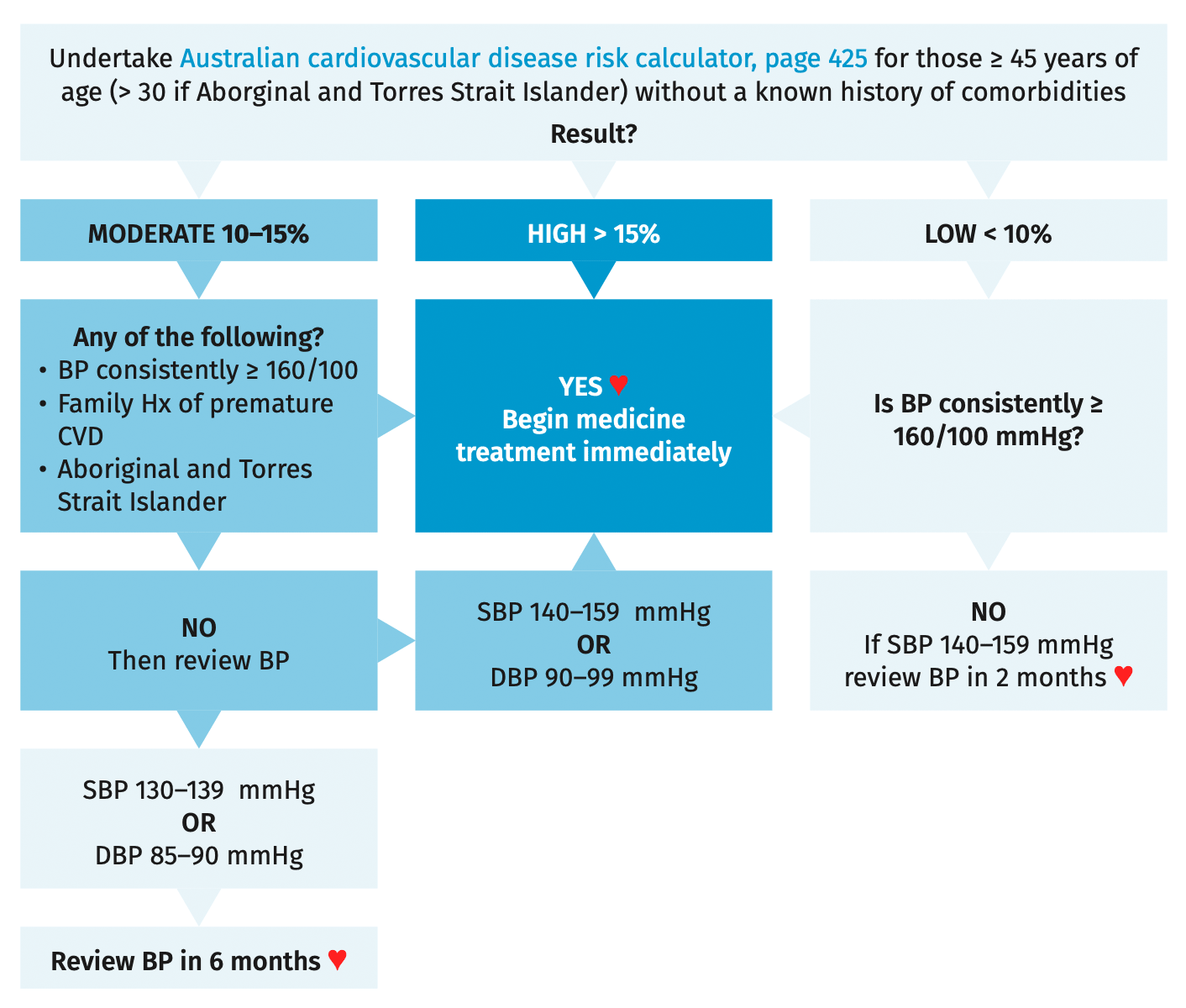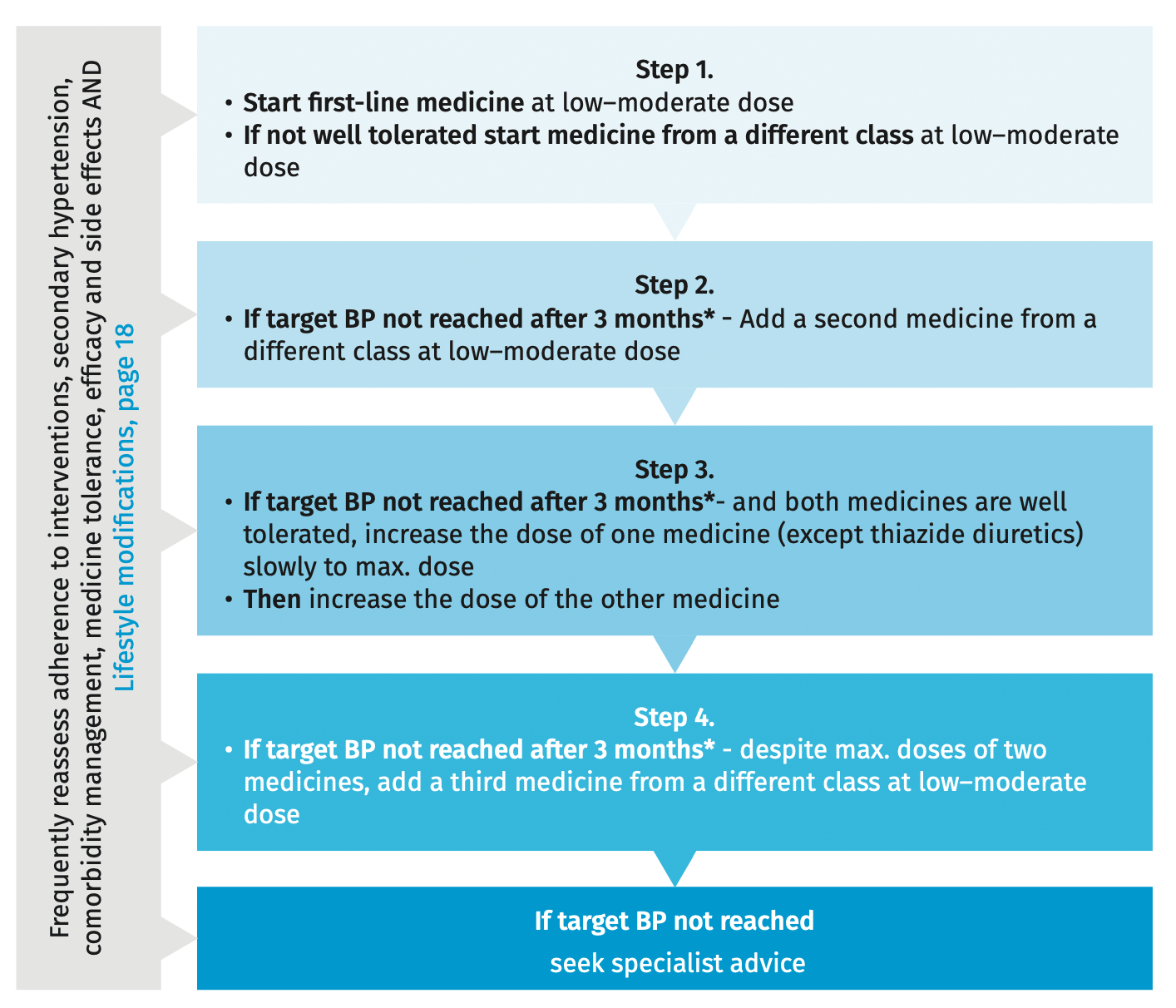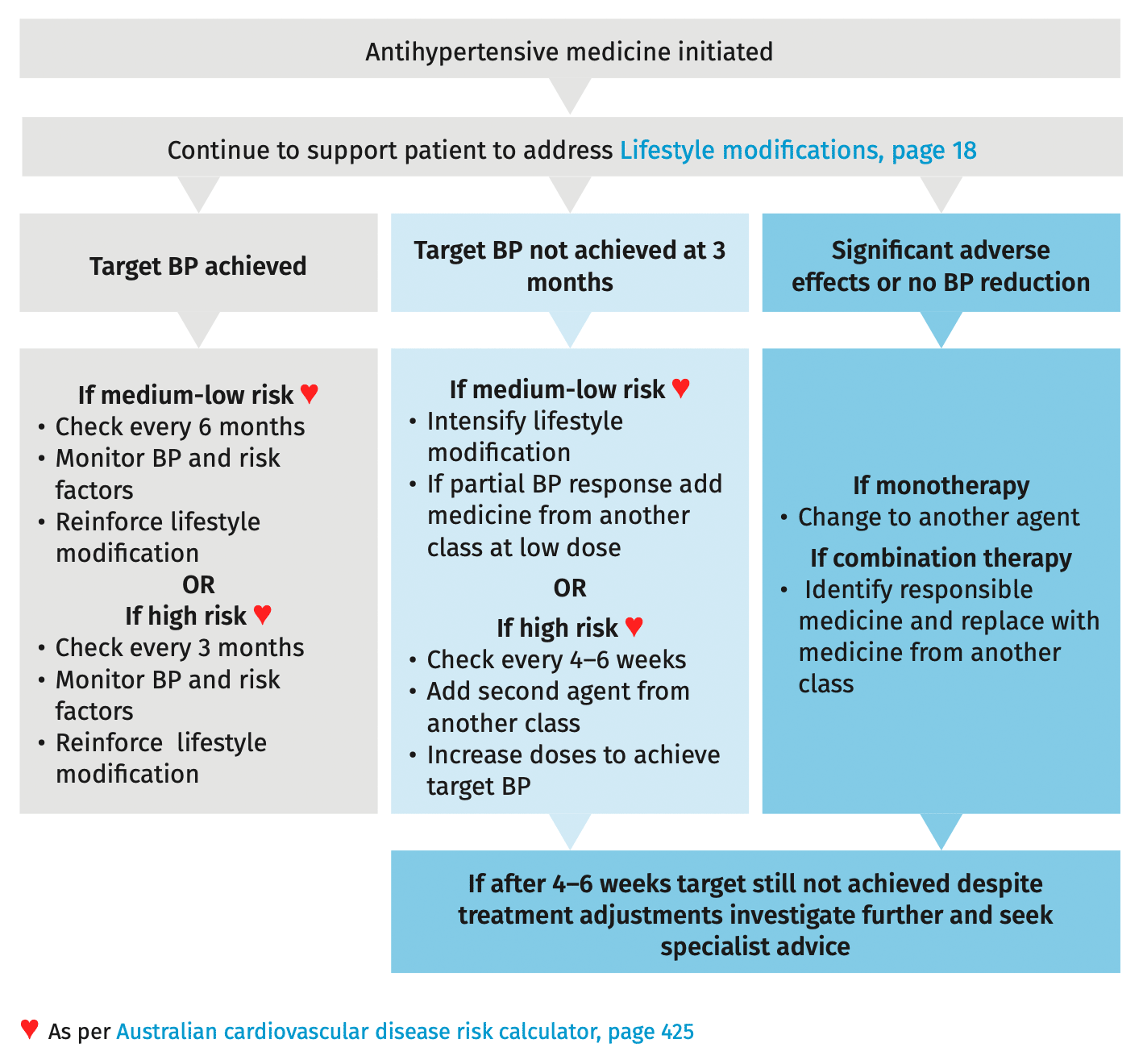High risk groups 1–3
- Aboriginal and Torres Strait Islander people
- Sedentary behaviours, overweight or obesity
- Low socioeconomic and ethnic minority groups
- Mental health comorbidities
- Elevated triglycerides, fibrinogen, apolipoprotein B, or high-sensitivity C-reactive protein
- Elevated fasting glucose but do not meet diabetes diagnosis criteria
- A family history of early cardiovascular disease (immediate relative < 55 yo for men and < 65 y for women)
Considerations in pregnancy 4
- Refer those with systolic blood pressure (SBP) ≥ 140 mmHg and/or diastolic BP (DBP) ≥ 90 mmHg to MO/NP for maternal investigations and fetal assessment
- See Queensland Maternity and Neonatal Clinical Guideline: Hypertensive disorders of pregnancy for further guidance. See Resource 1.
Urgent referral 1
- Refer to the Primary Clinical Care Manual for:
- BP ≥ 180/110 mmHg
- BP ≥ 170/110 mmHg in pregnancy
1. What is hypertension? 1–3
- A SBP ≥ 140 mmHg and/or a DBP ≥ 90 mmHg
- A persons BP varies according to age, gender and the presence of risk factors
- There are two types of hypertension:
- primary hypertension: attributed to lifestyle behaviours, age and genetics
- secondary hypertension: attributed to potentially reversible causes e.g.
medicines, pregnancy, sleep apnoea, kidney disease, endocrine disorders
- Elevated BP alters the function and structure of the circulatory system, damaging organs particularly the brain, heart, kidneys and the eyes
- People rarely know they have hypertension until their BP is checked
2. Diagnosis of hypertension 1–3
- Hypertension is based on multiple BP measurements taken on separate occasions, one or more weeks apart, or sooner if BP is ≥ 180/110 mmHg with evidence of CVD
- See Special considerations (child) or Clinical measurements (adult) to take a BP
- Hypertension can be confirmed with ambulatory or home monitoring and is supported by a thorough medical history, physical examination and laboratory investigations to identify comorbidities and CVD risk factors
- Patients with hypertension are often asymptomatic, however specific symptoms can suggest secondary hypertension including:
- muscle weakness or cramps
- arrhythmias or palpitations
- pulmonary oedema
- sweating or frequent headaches
- snoring or daytime sleepiness
- BP should be checked:
- annually for Aboriginal and Torres Strait Islander people > 18 years
- 2nd yearly for non-Aboriginal and Torres Strait Islander people > 18 years
- for all children > 10 years of age with a BMI > 85th centile for age and gender
3. Management of hypertension 1–3
- The goals of managing hypertension are to reduce cardiovascular risk profile and prevent end organ disease by:
- supporting patient to address Lifestyle modifications
- maintaining medicine regimens
- identifying and addressing comorbidities in the context of a patient’s Australian cardiovascular disease risk calculator:
- Dyslipidaemia
- Chronic kidney disease
- Overweight and obesity (adult)
- Diabetes
- Coronary heart disease,
- Stroke and transient ischaemic attack
- Atrial fibrillation
- Meeting target levels as per Table 1. and aiming for BP control within 3 months
Table 1. BP target levels 1–3 | |
|---|---|
Group | Target (mmHg) |
Normal | ≤ 130/85 |
Adults with uncomplicated hypertension | < 140/90 (lower if tolerated) |
Adults with hypertension > 75 years without diabetes | SBP < 120 |
In pregnancy | < 135/85 |
Hypertension with comorbidities or end organ damage e.g. coronary heart disease, diabetes, chronic kidney disease, stroke or TIA, COPD | < 130/80 |
Those with proteinuria > 1 g per day (with or without diabetes) | < 125/75 |
Children > 10 years of age with a BMI > 85th centile for age and gender | See Special considerations (child) |
- Support patient self-management 1–3
- Provide hypertension resources outlining what hypertension is and how it affects blood vessels, cardiovascular risk and other chronic conditions. See Resource 2.
- Reinforce the importance of adhering to BP medicine regimen
- Encourage the patient to identify barriers to adequate lifestyle modification and
medical adherence and to set goals to overcome those barriers. See Engaging our patients
- Social-emotional support
- See Social-emotional wellbeing
- Diet and nutrition 1,2
- High sodium (salt) intake increases blood pressure
- Reducing salt intake to < 4 g/day reduces SBP by 4–5 mmHg in hypertensive people and 2 mmHg in normotensive people
- Avoid cooking with salt and takeaway processed foods high in salt
- Increasing dietary potassium in hypertensive people with normal renal function can reduce SBP by 4–8 mmHg
- See Diet and nutrition
- Weight control 1–3
- Weight loss reduces BP, improves glycaemic control and Chronic kidney disease markers and reduces CVD risk and all-cause mortality
- A 1% reduction in body weight lowers systolic BP by an average of 1 mmHg
- A weight loss of 4.5 kg can reduce BP and prevent hypertension in Overweight and obesity (adult) and Overweight and obesity (child)
- Smoking cessation 1–3
- Smoking cessation reduces blood pressure, CVD risk and the chance of an acute coronary event within 2–6 years after quitting
- Alcohol reduction 1–3
- Consuming ≥ 2 standard drinks/day for men and ≥ 1 standard drinks/day for women increases the risk of developing hypertension
- See Alcohol reduction
- Physical activity 1–3
- Regular Physical activity and sleep lowers BP and all-cause mortality
- Monitoring 1
- Explaining clinic or home monitoring empowers patients to address lifestyle behaviours and adhere to management interventions
- Check BP at each visit and monitor according to 5. Cycle of care
- Refer for echocardiogram if Heart failure or murmur identified
4. Medicines for hypertension1,2
- As BP increases, it is more difficult to control with Lifestyle modifications alone and antihypertensive medicines become necessary
- Identify medicines that influence BP. See Table 2.
- Combination therapy is often necessary. Fewer than 50% of people treated for
hypertension will achieve an optimal BP response with a single agent - Combination of an ARB or ACEI, a diuretic and an NSAID (the ‘triple whammy’) can cause acute kidney injury. Avoid with kidney disease, dehydration and elderly patients
Table 2. Medicines that influence BP 1,3 | |
|---|---|
Prescription | Over the counter and complimentary |
|
|
Adapted with permission from the Guideline for the diagnosis and management of hypertension in adults. © 2016 National Heart Foundation of Australia | |
- Steps to initiate, monitor and adjust antihypertensives 1–3
- Step 1
- Undertake Australian cardiovascular disease risk calculator for:
- all people aged 45–79 years
- people with diabetes aged 35–79 years
- Aboriginal and Torres Strait Islander people aged 30–79 years
- Identify patients requiring immediate antihypertensive therapy:
- moderate or severe Chronic kidney disease:
- people with sustained eGFR < 45 mL/min/1.73m2, or
- men with persistent ACR > 25 mg/mmol, or
- women with persistent ACR > 35 mg/mmol, or
- a confirmed diagnosis of familial Dyslipidaemia
- Initiate antihypertensives as per Flowchart
- moderate or severe Chronic kidney disease:
- Undertake Australian cardiovascular disease risk calculator for:
- Step 2 – Choose and initiate medicines at lowest dose to reach target BP utilising Flowchart 2. and Table 3.
- Step 3 – Stabilise, maintain and monitor medicine doses according to patient response. See Flowchart 3.
- Commence at the lowest dose in elderly patients and those taking diuretics
- Potential benefits in diabetes, stroke/TIA, CKD, HF, AF and post MI
- Contraindicated or potentially harmful in bilateral renal artery stenosis and pregnancy
- As above with ACEi
- Use with caution in those who have experienced angioedema with ACE inhibitors
- Amlodipine and felodipine: lowest doses are recommended, particularly in the elderly
- Nifedipine: long-acting formulations are preferable
- Contraindicated or potentially harmful in heart failure
- It is usually unnecessary to exceed the doses shown
- Long term use not recommended in young patients due to risk of diabetes
- Potential benefits in stroke/TIA and heart failure
- Potential benefits in atrial fibrillation
- Contraindicated or potentially harmful in heart failure, bradycardia and 20 or 30 AV block
- Useful for elevated BP, post-MI, heart failure and stable angina
- Less effective than first-line medicines for uncomplicated hypertension to reduce stroke risk
- Contraindicated in bradycardia (45–50 bpm), 20 or 30 AV block, sick sinus syndrome (without pacemaker), severe hypotension and uncontrolled heart failure or asthma
- Assess benefits and risks of use in diabetes, well-controlled asthma or COPD
- Clonidine: rebound hypertension may occur with sudden cessation
- Hydralazine: used in combination with a beta-blocker or verapamil and a diuretic, to prevent reflex tachycardia. Maintenance doses above 100 mg daily are associated with increased risk of lupus-like syndrome and should not be given without determining patient’s acetylator status
- Contraindicated or potentially harmful in depression (clonidine, methyldopa, moxonidine)
Flowchart 1. Initiating antihypertensives according to absolute CVD risk 1,2
♥ Continue lifestyle modification, monitor BP, manage associated conditions and reassess cardiovascular risk regularly. Adapted with permission from the Guideline for the diagnosis and management of hypertension in adults. © 2016 National Heart Foundation of Australia
Flowchart 2. Medicine initiation strategy to reach target BP 1,2
* Maximum effect of medicine likely within 4–6 weeks
Table 3. Medicines for hypertension 1–3,5,6 |
|---|
First-line medicines |
Angiotensin converting enzyme inhibitors (ACEi) |
Lisinopril 5–40 mg PO daily OR Perindopril erbumine 4–8 mg PO daily OR Perindopril arginine 5–10 mg PO daily OR Ramipril 2.5–10 mg PO daily or in 2 equally divided doses |
Angiotensin II receptor antagonists (ARBs) |
Irbesartan 150–300 mg PO daily OR Telmisartan 40–80 mg PO daily |
Calcium channel blockers (dihydropyridine) |
Amlodipine 5–10 mg PO daily OR Felodipine MR 5–20 mg PO daily OR Lercanidipine 10–20 mg PO daily OR Nifedipine MR 30–120 mg PO daily |
Thiazide diuretics |
Hydrochlorothiazide 12.5–25 mg PO daily OR *Indapamide 1.25–2.5 mg PO daily OR Indapamide MR 1.5 mg PO daily |
Second-line medicines |
Calcium channel blockers (nondihydropyridine) |
Diltiazem MR180–360 mg PO daily OR Verapamil MR 120–480 mg PO daily (in divided doses if > 240mg) |
Beta-blockers |
Atenolol 25–100 mg PO daily OR Metoprolol tartrate 25–100 mg PO bd |
Other medicines |
Clonidine 50 microgs PO bd (to a max. 300 microgs bd) OR Hydralazine 25 mg PO bd (to a max. 100 mg bd) OR Methyldopa 125 mg PO bd (to a max. 500 mg tds) OR Moxonidine 200 microgs PO daily (to a max. 300 microgs bd or 200 microgs bd if eGFR 30–60 mL/min) OR Prazosin 0.5 mg PO bd (to a max. 10 mg bd) |
| *See LAM and PBS for medicine indications and restrictions |
Flowchart 3. Antihypertensive stabilisation, maintenance and monitoring 1,2
♥ As per Australian cardiovascular disease risk calculator
5. Cycle of care
Cycle of care summary for hypertension | ||
|---|---|---|
Action | Dx | Frequency |
Height | Annually until stops growing | |
BP | At each visit | |
Weight | 12 mthly | |
Waist circumference | 12 mthly | |
BMI | 12 mthly | |
Lifestyle modifications | At each visit | |
Social-emotional support | 12 mthly | |
Visual acuity | 12 mthly | |
Retinal imaging and fundoscopy | As per MO/NP or specialist 12 mthly | |
FBC | 12 mthly | |
UEC | 12 mthly or with change of meds | |
Fasting blood lipids | 12 mthly | |
Fasting blood glucose | 12 mthly | |
Urinalysis | 12 mthly | |
ACR | 12 mthly | |
ECG | 12 mthly | |
Echocardiogram | As per MO/NP | |
Chest x-ray | As per MO/NP | |
Influenza, pneumococcal and COVID-19 vaccines | Recommended. See the Australian Immunisation Handbook for schedule | |
HW/RN review | 3 mthly | |
MO/NP review | High risk 3 mth, low-medium risk 6 mthly | |
Medicine review | 3 mthly if medicine changed otherwise 12 mthly | |
Dentist review | 12 mthly | |
Dietitian review | 3 mthly | |
Specialist review | By MO/NP according to comorbidities | |
6. References
- All Chronic Conditions Manual references are available on the Office of Rural and Remote Health website